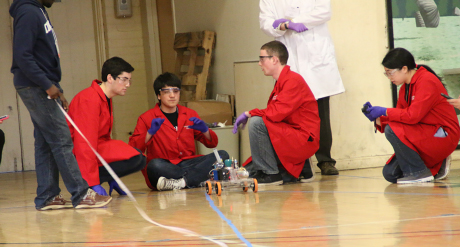Cornell's chemically engineered cars win again
By Bill Steele

Repeating past successes, Cornell collected top prizes in the Northeast Regional Chem-E-Car competition, April 5 at the University of Connecticut. The Cornell team entered a battery-powered car that took a first prize and a hydrogen fuel-cell-powered car that came in second. The team will go on to the national competition in the fall.
The event, part of the American Institute of Chemical Engineers Northeast Regional Student Conference, challenges students to build a shoebox-sized car that is both powered and controlled entirely by chemical reactions. The car must travel a distance between 50 and 100 feet, carrying a payload of up to 500 milliliters of water, and stop as close as possible to the designated finish line without brakes, timers or any other mechanical systems. The exact distance and payload are not announced until one hour before the first car runs, so contestants must design a chemical control system they can adjust to account for the specified distance and weight.
Both Cornell cars used an “iodine clock reaction” in which a solution containing starch and an iodine compound is combined with a mix of other chemicals that temporarily prevent iodine from precipitating out and combining with the starch. When the reaction is complete the transparent solution suddenly turns dark blue. A light beam passing through the solution falls on a photosensitive receptor that controls the drive motor. When the solution turns dark and breaks the light beam the car stops. The ratio of the two mixes of chemicals controls the time of the reaction.
Before the event, cars are displayed in a poster session and inspected by a panel of judges, primarily for safety. Teams must score at least 70 out of 100 in the poster session to be allowed to race. “We learn a lot from other teams,” DeRooy said.This method enabled the battery car to travel 82 feet and stop just about 20 inches from the line, while the fuel cell car landed about 24 inches from the line. This success grew from extensive testing – mostly in Cornell hallways – to calibrate how time, distance and payload would interact, said Brianna DeRooy ’14, senior team captain.
The Cornell team includes about 60 students from several fields of engineering, divided into sub-teams for various parts of the job. This includes “Potions” for the group that designs the timing reaction, and the equally important ”Finance,” which has obtained sponsorship from Merck, Air Products and the College of Engineering. The cars cost roughly between $300 and $2000 to build.
The students have spent most of the semester designing and building their cars in a lab space decorated by the skeletons of previous years’ cars. Last year’s Cornell team took first and third in the regional event, and the year before, Cornell won the national event.
The team is advised by Roseanna Zia, assistant professor of chemical and biomolecular engineering.
Media Contact
Get Cornell news delivered right to your inbox.
Subscribe